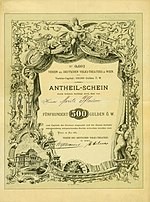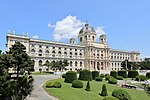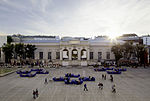The Austrian Parliament Building (German: Parlamentsgebäude, colloquially das Parlament) in Vienna is where the two houses of the Austrian Parliament conduct their sessions. The building is located on the Ringstraße boulevard in the first district Innere Stadt, near Hofburg Palace and the Palace of Justice. It was built to house the two chambers of the Imperial Council (Reichsrat), the bicameral legislature of the Cisleithanian (Austrian) part of the Austro-Hungarian Empire. Since its construction, the Parliament Building has been the seat of these two houses, and their successors—the National Council (Nationalrat) and the Federal Council (Bundesrat)—of the Austrian legislature.
The foundation stone was laid in 1874; the building was completed in 1883. The architect responsible for its Greek Revival style was Theophil Hansen. He designed the building holistically, aiming to have each element harmonising with all the others. He was therefore also responsible for the interior decoration, such as statues, paintings, furniture, chandeliers, and numerous other elements. Hansen was honoured by Emperor Franz Joseph with the title of Freiherr (Baron) after its completion. Following heavy damage and destruction in World War II, most of the interior has been restored to its original splendour.
The parliament building covers over 13,500 square meters, making it one of the largest structures on Ringstraße. It contains over one hundred rooms, the most important of which are the Chambers of the National Council, the Federal Council, and the former House of Deputies (Abgeordnetenhaus). The building also includes committee rooms, libraries, lobbies, dining rooms, bars and gymnasiums. One of the building's most famous features is the Pallas Athena fountain in front of the main entrance, built by Carl Kundmann after plans from Hansen, from 1898 to 1902 and it is a notable Viennese tourist attraction.
The Parliament Building is the site of important state ceremonies, most notably the swearing-in ceremony of the president of Austria. The building is closely associated with the two parliamentary bodies, as is shown by the use of the term Hohes Haus as a metonym for "Parliament". Parliamentary offices spill over into nearby buildings, such as the Palais Epstein.
After five years of renovations, the building is due to be reopened on 12 January 2023.












